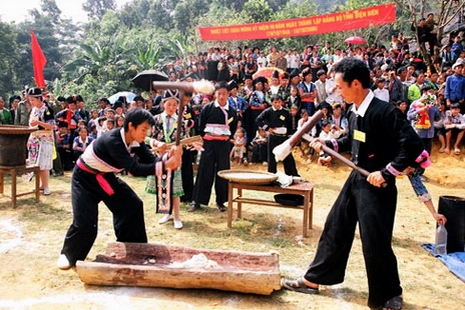|

It would be very interesting if you travel
northwest Vietnam in Spring time, from
January to March. The northwest of Vietnam is the home to many
ethnic minorities
like Hmong, Thai, Muong, etc. It is not hard to believe that this remote
highland can hold inside a widely diversified cultural background since each
ethnic group here has its own customs. When referring to Tet, these practices
have made great contributions to create unique Tet that you can only experience
on this land.
H'mong group in Hoa Binh
The H'Mong celebrate Tet one month earlier than the usual Tet in Vietnam. They
also do not celebrate New Year’s turning moment like the majority of Vietnamese
do. Instead, it is a tradition that New Year starts with the first rooster sound
on the first day of Tet. On the previous night, people set up a full table of
food and dedicate to their altar to worship the ancestors. After that, they have
a big meal with wine and wait until hearing the first rooster sound.
Another interesting custom is: rather than making “Chung” cake like the Kinh,
the Hmong make “Day” cake (a plain round sticky rice cake). They think that the
round shape of the cake represents the moon and the sun, which are the origin of
everything on earth. During Tet, these home-made cake will be used to treat the
guests.
Tet amongst Hmong people are full of social activities, spiritual customs, and
particularly traditional games like: horse racing, bird fighting, bow shooting,
etc.
Muong group in Son La
To the Muong, Tet is the most important event of the year. On Tet, each family
prepare a big meal to worship their ancestors and spiritual gods. A table often
requires: Chung cake, honey, wine, sticky rice, boiled meat, some money, a bowl
of water, betel and areca, salt. After setting up the table properly, the ritual
will be established by a sorcerer. Finally, the family can have New Year’s meal.
Besides the food prepared for ritual purpose, the Muong’s meal usually has some
additional local food and vegetable. A notable custom that is well practiced
here is: before the meal, children in the family must line up and show their
respect to the older by prostrating themselves before them. The old would then
wish their chidren health and luck. After settling, people would offer wine to
each other, and then start eating. To make the atmosphere warm and joyful, Muong
people often sing along traditional songs during the meal.
Thai group in Lai Chau
From January 25th (according to local calendar), after finishing cleaning and
decorating the house, Thai people will go to local markets to shop for Tet. Of
many things they would buy, two sugarcane trees are compulsory. It is a custom
that they bind the two trees in two side edges of the altar, which as the people
think, would do as a stick connecting land and the sky, guiding their ancestors
back to the sky for Tet.
In the early morning of 30th, Thai people would lit up their stoves to prepare
the food welcoming New Year. The women will make sticky rice and cook food while
the men will kill the pig and do initial procedures. At night, people gather
around the cooking fire to wait for New Year’s turning moment. Drums and gongs
spread out their cheerful melodies for an expecting New Year. When the clock
strikes 12, people in the village will go to the brook to take some water. The
tradition is that: if one uses the water from the source to drink and wash the
face at the very first time of New and his family will be healthy and lucky for
the rest of the year. This practice must be done before the first rooster sound
signaling 1 o’clock. |
